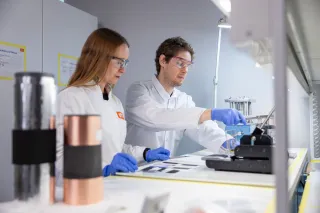Finland is now taking tough decisions to break its cycle of indebtedness. This cannot be done without economic growth. For a country like Finland, the key to sustainable growth is a skills-based strategy, which is why education and research, development and innovation (RDI) play such an important role in boosting economic growth. Parliament and the Government have made the right moves to create the conditions for growth – Finland now needs bold investments in potential growth areas.
Over the last 16 years, our economy has not grown as we would have wished, while public spending has risen significantly. These developments have led to Finland's public finances becoming indebted, and our ability to invest in the services, environment and security of the welfare society has weakened. We must engage in radical economic reform and we must do it in a sustainable way – we can’t continue to live at the expense of future generations.
A key and lasting way to strengthen our economy is to renew ourselves through education, research, development and innovation. Through RDI, we can create solutions that are useful for society and in demand worldwide such as digital solutions, health, environment and energy technologies.
Finland has already emerged as a leader in many areas by investing in renewal and innovation. In addition to the gaming industry, Finland is known for building cruise ships and mining machinery. We are also at the forefront of brand-new growth areas such as quantum technology. For example, Bluefors, which builds coolers for quantum computers that cool to a temperature close to absolute zero, is growing fast.
How can RDI investments hit the goldmine? How can we make sure that they’re effective?
To accelerate this positive development, the Finnish Parliament and Government have decided to increase public funding for RDI. Public authorities are not the best innovators, but they can be excellent enablers of innovation. The role of public authorities is to create the best environment for companies to invest in innovation and jobs in Finland. And that’s what’s needed now: an effort to share technological and commercial risk so that companies have the courage to invest. The aim is to "leverage" at least two private euros for every public euro.
Government RDI funding must be properly targeted and provided through the right instruments. We need long-term thematic choices, boldly directed at where we have particular excellence and a competitive advantage. A good example of this is Kvanttinova, under construction in Otaniemi, Espoo, where public money is being invested in an industry-led microelectronics and quantum technology pilot and development environment where companies can focus on pre-commercial development and piloting. Public investment will enable companies to make their own investments and, with this joint investment, Finland is becoming a major centre for microelectronics, even on a European scale. More than 20 companies have already committed to using Kvanttinova in their development work.
So what is holding back business investment? Known barriers include the technological and commercial risk associated with new technologies, regulation and the constraints it creates, and the availability of skilled labour and capital. Public RDI funding, properly targeted with the right instruments, can help to encourage risk-taking, but it is not enough on its own. In addition, regulation must support these objectives and make it more profitable to innovate than to stick with the old – something that is often forgotten when talking about RDI. Investing in training and attracting foreign talent will help tackle the third barrier.
Reform requires that private investors are attracted to invest in Finland and that companies and entrepreneurs harness RDI as a driver of competitiveness. Public money should be spent in a way that encourages businesses to exploit new scientific results in a manner that has not yet been done elsewhere. For example, public money can share with companies the risk of investing in clean technologies or new production technologies. We can create new production methods that use much less raw material, for example. This will create economic benefits and jobs while ensuring that the principles of sustainable development are respected.
Turning challenges into opportunities
A sustainable economy means products and services that provide solutions to major global challenges such as climate change, resource sufficiency, the circular economy, clean energy production, the responsible use of artificial intelligence or improving human health – all while respecting planetary boundaries. As we strengthen public-private cooperation and commitment to common goals, these challenges are also opportunities for Finland.
Bold investment, when wisely targeted, can turn our economy around. Overall, promoting Finland's prosperity, growth and sustainability requires a balanced approach combining long-term public investment, the private sector and innovation. The aim is to create prosperity, preserve and strengthen the welfare state and ensure that future generations can enjoy better opportunities and resources than we do. Together, we can achieve sustainable growth that benefits all Finns and lays the foundations for a prosperous future.




